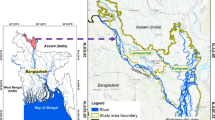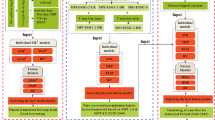Abstract
Flood is a recurrent and crucial natural phenomenon affecting almost the entire planet. It is a critical problem that causes crop destruction, destruction to the population, loss of infrastructure, and demolition of several public utilities. An effective way to deal with this is to alert the community from incoming inundation and provide ample time to evacuate and protect property. In this article, we suggest an IoT-based energy-efficient flood prediction and forecasting system. IoT sensor nodes are constrained in battery and memory, so the fog layer uses an energy-saving approach based on data heterogeneity to preserve the system’s power consumption. Cloud storage is used for efficient storage. The environmental conditions such as temperature, humidity, rainfall, and water body parameters, i.e., water flow and water level, are being investigated for India’s Kerala region to calibrate the flood phases. PCA (Principal Component Analysis) approach is used at the fog layer for attribute dimensionality reduction. ANN (Artificial Neural Network) algorithm is used to predict the flood, and the simulation technique of Holt Winter is used to forecast the future flood. Data are obtained from the Indian government meteorological database, and experimental assessment is carried out. The findings showed the feasibility of the proposed architecture.










Similar content being viewed by others
References
Abdurrahman M, Irawan B, Latuconsina R (2017) Flood forecasting using holt-winters exponential smoothing method and geographic information system. In: International conference on control, electronics, renewable energy and communications (ICCREC), 2017, pp 159–163, https://doi.org/10.1109/ICCEREC.2017.8226704
Afzaal H, Zafar N (2016) Cloud computing based flood detection and management system using WSANs. Int Conf Emerg Technol (ICET) 2016:1–6
Avvenuti M, Cresci S, Vigna FD, Tesconi M (2017) On the need of opening up crowdsourced emergency management systems. AI Soc 33:55–60
Aziz K, Rahman A, Fang G, Shrestha S (2013) Application of artificial neural networks in regional flood frequency analysis: a case study for Australia. Stoch Environ Res Risk Assess 28:541–554
Basha E, Ravela S, Rus D (2008) Model-based monitoring for early warning flood detection. In: SenSys’08 - Proceedings of the 6th ACM conference on embedded networked sensor systems. 295-308. https://doi.org/10.1145/1460412.1460442
Chu K, Liu W, She Y, Zulin H, Tan M, Liu X, Gu L, Jia Y (2018) Modified principal component analysis for identifying key environmental indicators and application to a large-scale tidal flat reclamation. Water 10:69. https://doi.org/10.3390/w10010069
Floods - National Disaster Management Authority. [Online]. Available: http://www.ndma.gov.in/en/mediapublic-awareness/disaster/naturaldisaster/floods.html
FMIS.” [Online]. Available: http://fmis.bih.nic.in/Riverbasin.html
Ghadim HB, Heydari M, Rashidi M, Noori M (2018) Application of Holt-Winters time series models for predicting climatic parameters (case study: Robat Garah-Bil Station, Iran). Polish J Environ Stud. https://doi.org/10.15244/pjoes/100496
Gilandeh A, Sobhani B, Ostadi E (2020) Combining Arc-GIS and OWA model in flooding potential analysis (case study: Meshkinshahr city). Nat Hazards. https://doi.org/10.1007/s11069-020-03975-0
Gourbesville P, Batica J, Tigli J, Lavirotte S, Rey G, Raju D (2012) Flood warning systems and ubiquitous computing. La Houille Blanche 98:11–16
Goymann P, Herrling D, Rausch A (2019) Flood prediction through artificial neural networks: a case study in Goslar, Lower Saxony. In: The eleventh international conference on adaptive and self-adaptive systems and applications. Venice, Italy
Hadid B, Duviella E, Lecoeuche S (2020) Data-driven modeling for river flood forecasting based on a Piecewise Linear ARX system identification. J Process Control 86:44–86. https://doi.org/10.1016/j.jprocont.2019.12.007
Hashi AO, Abdirahman AA, Elmi MA, Hashim SZM (2021) A real time flood detection system based on machine learning algorithms. Innovative systems for intelligent health informatics. In: IRICT, (2020) vol 72. Springer, Cham
Hernández-Nolasco J, Ovando MA, Acosta FD, Pancardo P (2016) Water level meter for alerting population about floods. In: 2016 IEEE 30th international conference on advanced information networking and applications (AINA), pp 879–884
Hong H, Panahi M, Shirzadi A, Ma T, Liu J, Zhu AX, Chen W, Kougias I, Kazakis N (2018) Flood susceptibility assessment in Hengfeng area coupling adaptive neuro-fuzzy inference system with genetic algorithm and differential evolution. Sci Total Environ 621:1124–1141. https://doi.org/10.1016/j.scitotenv.2017.10.114
Hoseini Y, Azari A, Alireza Pilpayeh (2016) Flood modeling using WMS model for determining peak flood discharge in southwest Iran case study: Simili basin in Khuzestan Province. Appl Water Sci. https://doi.org/10.1007/s13201-016-0482-4
Human cost of disasters: An overview of the last 20 years 2000–2019. Centre for Research on the Epidemiology of Disasters (CRED), UNDRR
India Water Portal, http://www.indiawaterportal.org/articles/district-wise-monthly-rainfall-datalist- rain-stations-india-metrologicaldepartment
Indian Meteorological Department, http://www.imd.gov.in
Kumar VA, Girish B, Rajesh K (2015) Integrated weather and flood alerting system. Int Adv Res J Sci Eng Technol 2(6):21–24
Leitão J, Cardoso A, Marques JA, Simões N (2017) Flood management in urban drainage: contributions for the control of water drainage systems using underground barriers. In: 2017 4th experiment international conference, pp 286–291, https://doi.org/10.1109/EXPAT.2017.7984346
Lo SW, Wu JH, Lin FP, Hsu CH (2015) Visual sensing for urban flood monitoring. Sensors (Basel, Switzerland) 15:20006–20029
Lyons EA, Sheng Y, Smith LC, Li J, Hinkel HM, Lenters JD, Wang J (2011) Quantifying sources of error in multitemporal, Landsat-based lake mapping. Int J Remote Sens
Machekposhti K, Sedghi H, Telvari A, Babazadeh H (2018) Flood predicting in Karkheh River Basin using Stochastic ARIMA model. Int J Agric Biosyst Eng 12(3):89–96
Ma N, Yuan M, Bao Y, Jin Z, Zhou H (2010) The design of meteorological data warehouse and multidimensional data report. In: Proceedings of second international conference on information technology and computer science. pp 280–283
Moishin M, Deo R, Prasad R, Raj N, Abdulla S (2021) Designing deep-based learning flood forecast model with ConvLSTM hybrid algorithm. IEEE Access. https://doi.org/10.1109/ACCESS.2021.3065939
Mukerji A, Chatterjee C, Raghuwanshi N (2009) Flood forecasting using ANN, neuro-fuzzy, and neuro-GA models. J Hydrol Eng 14:647–652. https://doi.org/10.1061/(ASCE)HE.1943-5584.0000040
MunichRENatCatSERVICE. Availableonline:https://natcatservice.munichre.com/
Nguyen KT, Chua LHC, Son LH (2014) Flood forecasting in large rivers with data-driven models. Nat. Hazards 71(1):767–784
Noori R, Khakpour A, Omidvar B, Farokhnia A (2010) Comparison of ANN and principal component analysis-multivariate linear regression models for predicting the river flow based on developed discrepancy ratio statistic. Exp Syst Appl 37:5856–5862
Ongdas N, Akiyanova F, Karakulov Y, Muratbayeva A, Zinabdin N (2020) Application of HEC-RAS (2D) for Flood hazard maps generation for Yesil (Ishim) River in Kazakhstan. Water 12:2672
Owotoki P, Manojlovic N, Lindenberg FM, Pasche E (2006) A data mining approach for capacity building of stakeholders in integrated flood management. In: Proceedings of the sixth international conference on data mining (ICDM’06). 0-7695-2701-9/06-2006 IEEE
Puah Y, Yuk Huang, Chua K, Lee T (2016) River catchment rainfall series analysis using additive Holt-Winters method. J Earth Syst Sci. https://doi.org/10.1007/s12040-016-0661-6
Ray PP, Mukherjee M (2017) Internet of things for disaster management: state-of-the-art and prospects. IEEE Access 5:2169–3536
Razak NH, Aris AZ, Ramli MF, Looi LJ, Juahir H (2018) Temporal flood incidence forecasting for Segamat River (Malaysia) using autoregressive integrated moving average modelling. J Flood Risk Manag 11:S794–S804
Rehman S, Sahana M, Hong H et al (2019) A systematic review on approaches and methods used for flood vulnerability assessment: framework for future research. Nat Hazards 96:975–998. https://doi.org/10.1007/s11069-018-03567-z
Romali N, Yusop Z, Ismail A (2018) Hydrological modelling using HEC-HMS for flood risk assessment of Segamat Town, Malaysia. IOP Conf Ser Mater Sci Eng 318:012029. https://doi.org/10.1088/1757-899X/318/1/012029
Sakhardande P, Hanagal S, Kulkarni S (2016) Design of disaster management system using IOT based interconnected network with smart city monitoring. In: International conference on Internet of Things and applications (IOTA), India
Sakib SN, Ane T, Matin N, Kaiser M (2016) An intelligent flood monitoring system for Bangladesh using wireless sensor network. In: 2016 5th international conference on informatics, electronics and vision (ICIEV), pp 979–984
Shih DS, Chen CH, Yeh GT (2014) Improving our understanding of flood forecasting using earlier hydrometeorological intelligence. J Hydrol 512:470–481
Sood S, Sandhu R, Singla K, Chang V (2017) IoT, big data and HPC based smart flood management framework. Sustain Comput Inform Syst. https://doi.org/10.1016/j.suscom.2017.12.001
Supatmi S, Hou R, Sumitra ID (2019) Study of hybrid neurofuzzy inference system for forecasting flood event vulnerability in Indonesia. Comput Intell Neurosci
Tayfur G, Singh V, Asce F (2006) ANN and fuzzy logic models for simulating event-based rainfall-runoff. J Hydraulic Eng ASCE. https://doi.org/10.1061/(ASCE)0733-9429(2006)132:12(1321)
Tur R, Can B, Koç M (2010) Artificial neural networks based on principal component analysis, fuzzy systems and fuzzy neural networks for preliminary design of rubble mound breakwaters. Appl Ocean Res 32:425–433. https://doi.org/10.1016/j.apor.2010.09.005
UttarakhandStat Provides Comprehensive Information on All The Major Sectors of The State Level Consolidated Research Statistical Data. [Online]. Available: http://www.uttarakhandstat.com/default.aspx
Vinothini K, Jayanthy S (2019) IoT based flood detection and notification system using decision tree algorithm. In: 2019 international conference on intelligent computing and control systems (ICCS), pp 1481–1486, https://doi.org/10.1109/ICCS45141.2019.9065799
Widmann M, Schar C (1997) Principal component and long-term trend analysis of daily precipitation in Switzerland. Int J Climatol 17:1333–1356
Wu CL, Chau KW, Fan C (2010) Prediction of rainfall time series using modular artificial neural networks coupled with data preprocessing techniques. J Hydrol 389(1–2):146–167
www.newsclick.in (Accessed 5 Dec 2020)
Yusoff A, Mustafa IS, Yussof S, Md. Din N (2015) Green cloud platform for flood early detection warning system in smart city. In: The 5th national symposium on information technology: towards new smart world (NSITNSW). 978-1-4799-7626-3/15/2015 IEEE
Zhu X, Zhang G, Sun B (2019) A comprehensive literature review of the demand forecasting methods of emergency resources from the perspective of artificial intelligence. Nat Hazards 97:65–82. https://doi.org/10.1007/s11069-019-03626-z
Author information
Authors and Affiliations
Corresponding author
Ethics declarations
Conflict of interest
The authors declare that they have no conflict of interest.
Additional information
Publisher's Note
Springer Nature remains neutral with regard to jurisdictional claims in published maps and institutional affiliations.
Rights and permissions
About this article
Cite this article
Kaur, M., Kaur, P.D. & Sood, S.K. Energy efficient IoT-based cloud framework for early flood prediction. Nat Hazards 109, 2053–2076 (2021). https://doi.org/10.1007/s11069-021-04910-7
Received:
Accepted:
Published:
Issue Date:
DOI: https://doi.org/10.1007/s11069-021-04910-7




